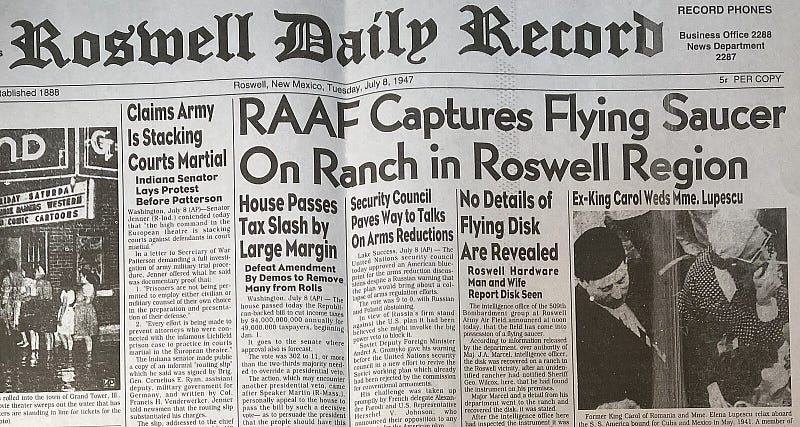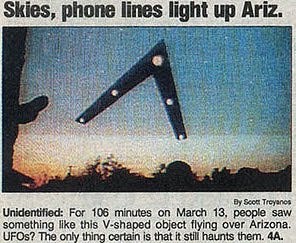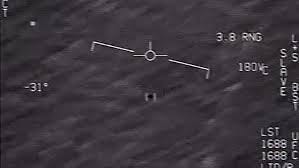Exploring the Mystery of UFOs: Fact or Fiction?
Written on
Chapter 1: Understanding UFOs
The phenomenon of UFOs (Unidentified Flying Objects) has intrigued people for many years. The allure of flying saucers and potential alien visitors has been perpetuated through films, television, and literature. However, a pressing question remains: Are UFOs genuine, or can all sightings be clarified through scientific reasoning? This inquiry has captivated scientists, governmental bodies, and the general public alike.
In this article, we will define UFOs, recount notable sightings, assess scientific explanations for these occurrences, and consider whether UFOs could indicate extraterrestrial existence.
Section 1.1: Definition of UFOs
Before we can determine the reality of UFOs, it's essential to clarify what constitutes a UFO. The acronym "UFO" refers to any aerial object that observers cannot identify promptly. It does not inherently imply that the object is an alien spacecraft.
Most UFO encounters eventually reveal mundane explanations. For instance, what may appear to be an unidentified flying object could simply be a weather balloon, a conventional aircraft, or a drone. Nevertheless, some sightings remain unresolved, which contributes to the speculation that they might represent evidence of extraterrestrial life.
Subsection 1.1.1: Historical Sightings

Section 1.2: Notable UFO Cases
Throughout history, various UFO sightings have captured global attention. Here are a few of the most notable cases:
The Roswell Incident (1947)
One of the most renowned UFO events is the Roswell incident. In July 1947, a rancher in Roswell, New Mexico, discovered debris scattered across his land. The military promptly collected the remains, fueling rumors that they were part of a crashed alien spacecraft. Initially, the military referred to the debris as a "flying disc," but later retracted that statement, claiming it was merely a weather balloon.
Despite the official narrative, Roswell has become a cornerstone of UFO lore. Many believe that the U.S. government concealed the recovery of extraterrestrial technology. The truth remains elusive, but the incident continues to inspire documentaries, literature, and conspiracy theories.
The Phoenix Lights (1997)
In 1997, thousands of witnesses in Phoenix, Arizona, observed an unusual display known as the Phoenix Lights. A series of luminous orbs formed a V-shaped configuration in the sky, captivating observers for hours, including pilots and military personnel.
While the military later attributed the lights to flares from a National Guard exercise, skepticism persisted. The Phoenix Lights remain one of the most frequently discussed and documented UFO events.

The Tic Tac UFO (2004)
In 2004, U.S. Navy pilots encountered what became known as the Tic Tac UFO. During a training drill off California's coast, they observed a peculiar white object resembling a Tic Tac candy, moving at astonishing speeds without visible wings or engines, defying the known laws of physics.
The encounter was recorded on video by the Navy and later verified as authentic by the U.S. government. This sighting reignited public interest in UFOs, as even trained military personnel struggled to explain what they had witnessed.

Chapter 2: Scientific Explanations for UFO Sightings
Many UFO sightings can be rationally explained. Let’s delve into some common scientific interpretations of these occurrences.
Section 2.1: Natural Phenomena
One prevalent explanation for UFO sightings is natural phenomena. Events such as meteors, unique weather patterns, and atmospheric conditions can create unusual visual effects in the sky. For example, a bright meteor may flash across the sky, appearing as a rapid-moving UFO. Similarly, ball lightning, a rare glowing sphere caused by electrical activity, has been misidentified as a UFO.
Additionally, Venus, one of the brightest celestial bodies, can often be confused for a UFO, particularly when low on the horizon, due to its brilliance and slow movement.
Section 2.2: Aircraft and Military Tests
Many UFO sightings result from misidentifications of conventional aircraft, especially military jets. Governments frequently conduct secret tests of new aircraft, which can be mistaken for UFOs. For instance, during the Cold War, the U.S. military developed high-altitude reconnaissance planes like the U-2 and the SR-71 Blackbird, which were often misconstrued as UFOs due to their atypical appearance and flight paths.
Some sightings have been confirmed as experimental military aircraft or advanced technology that was previously unknown to the public, explaining why certain cases remain ambiguous for years.
Section 2.3: Optical Illusions and Psychological Factors
Human perception can sometimes be deceptive, particularly when encountering unfamiliar objects in the sky. Optical illusions and psychological influences can lead us to misinterpret ordinary objects as extraordinary. For example, bright reflections or cloud movements can create misleading impressions.
Moreover, confirmation bias plays a significant role. Individuals expecting to see something unusual may interpret everyday occurrences as extraordinary phenomena. If someone spots a bright light in the sky and is already inclined to believe in UFOs, they might hastily conclude it's an alien spacecraft, overlooking more plausible explanations.
Section 2.4: Hoaxes
Throughout history, numerous hoaxes and fabricated UFO sightings have emerged. Some individuals have orchestrated elaborate pranks to suggest UFOs are real, either for amusement or to garner attention. Techniques involving drones, balloons, and other methods have been used to create fake UFOs, sometimes successfully deceiving both the media and the public.
While hoaxes do not account for all UFO sightings, they have certainly contributed to the mythology surrounding the subject.
Chapter 3: Government Involvement and UAP Reports
In recent years, the U.S. government has begun to take the subject of UFOs more seriously. Rather than using the term "UFO," officials now refer to these occurrences as UAPs — Unidentified Aerial Phenomena. This change is partly due to the negative connotations associated with the term "UFO," which often evokes images of aliens, whereas "UAP" aims to adopt a more neutral and scientific tone.
In 2020, the U.S. Department of Defense publicly released three videos depicting encounters between Navy pilots and unidentified flying objects. Although these videos had previously circulated, the government's acknowledgment was significant. The footage showcases objects moving at remarkable speeds and executing maneuvers that no known human-made aircraft can replicate.
In 2021, the U.S. government released a report addressing UAPs, analyzing 144 sightings reported by military personnel from 2004 to 2021. Out of these, only one was attributed to a deflating weather balloon; the remaining 143 sightings remain unexplained. However, the report stressed that there is no evidence suggesting these objects are of extraterrestrial origin.
The government has indicated that UAPs may pose safety risks, particularly for military pilots, and plans to continue investigating these phenomena. Yet, the lack of definitive evidence regarding the nature of these objects has led many to speculate about the existence of aliens.
Chapter 4: Are UFOs Evidence of Extraterrestrial Life?
This leads us to the pivotal question: Do UFOs indicate the presence of extraterrestrial beings? Although UFOs exist in the sense that people have reported seeing unidentifiable objects, no solid proof has emerged to confirm that these items are alien spacecraft.
The vast majority of UFO sightings have been attributed to natural occurrences, aircraft, or other human-made objects. Even the U.S. government’s report on UAPs did not imply that the unexplained sightings were of extraterrestrial origin, instead emphasizing the necessity for further investigation.
Nevertheless, the prospect of alien life remains a possibility. Scientists speculate that life could exist beyond Earth, especially given the discovery of potentially habitable planets outside our solar system. However, without direct evidence—such as communication from extraterrestrials or an alien craft landing on Earth—we cannot definitively state that UFOs prove the existence of aliens.
Chapter 5: The Ongoing Search for Answers
The fascination with UFOs and UAPs continues to captivate the public, and the quest for answers is ongoing. As technology evolves and more individuals gain access to tools like smartphones and cameras, we may obtain clearer images and additional data on these enigmatic sightings.
In the scientific realm, the emphasis is on gathering more evidence and rigorously investigating these phenomena. Whether UFOs turn out to be advanced military technology, rare natural events, or something more extraordinary, the pursuit of knowledge remains steadfast.
So, are UFOs real? The answer is affirmative—but perhaps not in the way many assume. UFOs are merely objects that cannot be promptly identified, and most sightings have been clarified through scientific means as either natural or human-made. However, some reports remain unresolved, and the possibility of extraterrestrial life keeps the conversation alive.
While definitive evidence of alien visitation has yet to surface, the intrigue surrounding UFOs is likely to endure for generations. As we continue to explore the mysteries of the universe, we may one day uncover the answers we seek. Until that time, we can only gaze at the stars and ponder: Are we truly alone in this vast cosmos?
The first video titled "The Proof Is Out There: 4 UNEXPLAINABLE UFO SIGHTINGS" delves into four notable sightings that remain unexplained, examining the evidence and theories surrounding each case.
The second video, "Ancient Aliens: Inside Area 51's UFO Secrets," explores the mysteries and secrets associated with Area 51, a site long associated with UFO sightings and alleged extraterrestrial technology.